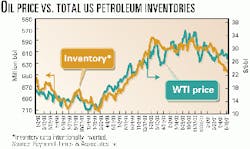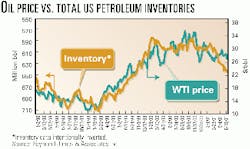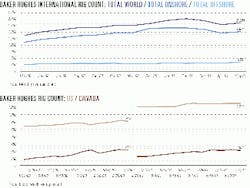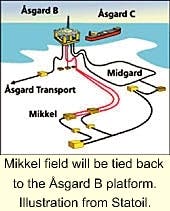Market Movement
Oil price forecasts lowered
Financial analyst Raymond James & Associates lowered its oil price forecast after maintaining one of Wall Street's more bullish forecasts for 2 years.
Analyst Marshall Adkins said, "Deterioration of global oil demand growth has been even more severe that we had originally thought." RJA lowered its third quarter oil price forecast from $28/bbl to $25/bbl. The 2002 forecast also was lowered from $30/bbl to $26/bbl.
"If we exclude the impact of first quarter fuel switching in North America, it now appears that global oil de- mand growth will amount to only 600,000-700,000 b/d, or a 0.9% year-over-year increase," Adkins said.
Slowing demand growth means growing US petroleum inventories. "These inventories are now 45 million bbl, or 7%, above year-ago levels and are above 10-year inventory averages," he said. The levels of US inventories tend to drive world oil prices, he added.
World oil prices have had an inverse correlation with total US petroleum inventories (see chart). "At current inventory levels, oil prices should be trading in the low $20 range," he said.
But he sees several oil price positives that should limit the oil price downside over time. "We believe that 1) lack of non-OPEC supply increases, 2) improving fourth quarter seasonal demand, 3) strong OPEC resolve, and 4) limited Iraqi production will be sufficient to maintain average oil prices above $25. Even though we will continue to see volatility and possible dips well below $25, longer-term supply-demand numbers support a mid to high $20 price through next year," Adkins said.
Gas storage injections keep pace
AGA reported that US gas storage injections for the week ended July 6 were 110 bcf compared with a 97 bcf injection rate the same week last year, a 59 bcf injection in 1999, and a 105 bcf injection the previous week. The injection was at the low end of the estimate by Salomon Smith Barney analyst Robert Morris.
Storage levels stand at 1,932 bcf, or 199 bcf higher than 1 year ago. But comparisons for year-to-year and week-to-week are hindered because of the July 4 holiday week, he said. The shortened work week resulted in reduced electricity demand for factories and office buildings.
onetheless, injections would have to average only 1.3 bcfd over last year for the rest of the season in order for storage levels to reach 3.1 tcf at the beginning of November compared with nearly 2.75 tcf last year, he said.
US supply-demand gap widens
Sheikh Ahmed Zaki Yamani, chairman of the Centre for Global Energy Studies, described the US energy situation as "a study in underinvestment vs. rampant demand" in a speech to the International Energy Agency's Millennium Conference on Energy Security in Paris earlier this year.
"US energy demand has grown since 1983 at an average rate of almost 2%[/year], reaching the equivalent of 50 million b/d of oil last year. Primary energy production, on the other hand, has grown by an average of just 0.7%[/year] over the same period, leaving the US with a widening gap between domestic demand and supply," Yamani said.
The latest forecasts from the US DOE in its US Annual Energy Outlook show energy demand 30% higher by the year 2020. Considerable development of gas reserves, both in the US and Canada, and a further jump in oil imports to almost two-thirds of aggregate oil demand, would be needed to match such a rise in consumption.
Yamani said, "A growing energy deficit is not the only problem facing the US. Underinvestment in new capacity and a congested and aging infrastructure, which impedes the flow of energy between regions, are also adding to the nation's problems-as reflected in miniature in California. The oil, gas, and electricity sectors all display similar inefficiencies, with soaring demand running ahead of production and transportation systems that are suffering from many years of underinvestment."
Surging gas demand has led to a rise in gas pipeline utilization in the US. The electricity transmission grid is also highly congested. Oil imports are now required to supply more than half of annual US consumption, and the proportion covered by such imports is expected to rise to over 60% by 2020, he said.
null
null
null
Industry Trends
E&P COMPANY STOCK VALUES HAVE DROPPED SHARPLY ALONG WITH NATURAL GAS PRICES in the last few months.
So says Lehman Bros. analyst Thomas Driscoll in a recent research note. In fact, most E&P shares have fallen more than 20% since early March, Driscoll noted, when Lehman Bros. said it had "warned investors that gas markets were out of balance."
"...Natural gas prices could fall to $2.50/MMbtu over the next several months as supply and demand come into balance. For the longer termellipseinvestors are likely to value the shares using a natural gas price forecast of about $3/MMbtu and an oil price forecast of about $21/bbl. Using this price scenarioellipsethe average E&P share is 3% above fair value," Driscoll said.
SIMMONS & CO. SAYS THE STOCK OF INTEGRATED ENERGY FIRMS IS TRADING AT ATTRACTIVE VALUATIONS despite concerns about deregulation coupled with weakening natural gas and electricity prices. "We are expecting power generation economics to be above historical averages in most (but not all) regions through 2003," analyst Jeff A. Dietert said in a recent report.
This expectation is based upon normal weather conditions and historical demand growth. "In addition to tight natural gas and electricity markets, the energy delivery system in North America is highly utilized and increasingly capacity constrained, creating opportunity for investment in new pipeline and transmission infrastructure," he said.
DURING THE NEXT 5 YEARS, POWER PRICES IN THE US EAST WILL DECLINE WHILE POWER PRICES IN THE WEST WILL RISE.
Energy Security Analysis Inc. said deregulation is working in the East. Already, new generation and transmission projects in the Northeast power pools are having an impact on prices, Kristin Dally, ESAI senior power analyst, said. The West faces a different situation.
"The moral hazard created by state and federal government interventions are shaping the future of western energy markets. In essence, California's inability to create a viable framework for electricity markets virtually assures that its citizens will have to pay higher prices for power for decades," she said. ESAI said FERC and actions by California have locked in high forward prices for years to come.
THE ASIA-PACIFIC REGION IS A HUGE NET IMPORTER OF CRUDE AND REFINED PRODUCTS, AND THAT IMPORT DEPENDENCE IS GROWING.
According to FACTS Inc., in 2000, the region's crude oil production, including condensate, was estimated at 7.65 million b/d, up from 7.53 million b/d in 1999.
"Over the next 5-10 years, regional crude oil production is expected to decrease slightly to 7.49 million b/d in 2005ellipseowning to the production decrease in Australia and Indonesia," the analyst said (see chart).
Beyond 2004, oil production in Australia, Viet Nam, Malaysia, and Indonesia is expected to decline, FACTS said.
Government Developments
GOP CONGRESSMEN HAVE TAKEN IT UPON THEMSELVES TO PROMOTE THE NEW US ENERGY POLICY.
Texas Republican Congressmen Tom DeLay, Kevin Brady, and John Culberson scheduled a Houston Town Hall on Energy for July 16. Meanwhile, Vice-Pres. Dick Cheney, five Cabinet secretaries, and more than 25 Republican congressmen conducted other energy-related events nationwide to build voter support for their proposed energy policy.
CONGRESS IS DELIBERATING WHERE TO ALLOW DRILLING IN THE US.
Following the lead of the US House late last month, the US Senate agreed to block new energy leases in designated national monuments. The measure is likely to be retained in a final bill sent to President George W. Bush later this summer. The drilling ban came in a funding bill for oil-related programs overseen by the departments of Interior and Energy.
Meanwhile, Republican leaders have renewed an uphill campaign to pass legislation opening the Arctic National Wildlife Refuge coastal plain for exploration. The House Resources Committee last week began a hearing on energy policy reform legislation, including ANWR leasing. Sup- porters testified that opening a small portion of the coastal plain could yield the largest oil field the industry has found in more than a generation. (See Watching Government, p. 28).
LAST MONTH, THE US HOUSE APPROVED A BILL THAT WOULD BAN NEW DIRECTION AL DRILLING FOR OIL AND GAS BENEATH THE GREAT LAKES.
That decision drew the ire of oil and gas industry leaders who argue the legislation hinders Michigan's ability to fulfill its energy needs. Michigan Oil & Gas Association Pres. Frank L. Mortl said the House members supporting the amendment "made politics more important than scientific evidence." Robb Gillespie, assistant director of the Michigan Basin Core Research Laboratory and geology professor at Western Michigan University, said scientific evidence shows directional drilling is safe and poses no risk to the lake water or the environment. Currently, seven directional wells operate under Lake Michigan and Lake Huron. Six of those wells produce gas, and one produces oil.
PDVSA MIGHT EXPLORE ABROAD, POSSIBLY IN JOINT PROJECTS WITH OTHER OPEC MEMBERS.
Deputy Energy and Mines Minister Bernardo Alvarez said the Venezuelan state oil firm is contemplating how to expand its operations. "Our basic problem is to fulfill our commitments within OPEC, but there also could be exploration in conjunction with other OPEC countries," he said, adding that any such decision would depend upon a new OPEC policy.
"The policy cannot just be about defending prices, we have to develop alternative plans," said Alvarez, noting that OPEC is open to suggestions.
His comments followed earlier remarks made by PDVSA Pres. Gen. Guaicaipuro Lameda that the option of producing oil abroad "is being studied."
Quick Takes
EXXONMOBIL CHEMICAL BROUGHT ITS SINGAPORE CHEMICAL COMPLEX ON STREAM, CONSTITUTING ITS LARGEST INVESTMENT IN THE ASIA-PACIFIC REGION.
The $2 billion petrochemical complex on Jurong Island is integrated with ExxonMobil's Singapore refinery. The complex has four plants, the centerpiece of which is an 800,000-ton/year steam cracker that produces ethylene, propylene, and other products.
The complex also features a 480,000-tonne/year polyethylene plant-which is the largest single reactor plant of its type in the world-along with a 315,000-tonne/year polypropylene plant and a 150,000-tonne/year oxo alcohol plant. A 155-Mw cogeneration unit provides power to the chemical complex and the refinery.
Work on the complex began in 1997. During the next few months, testing on the project will be completed, at which time the complex will ramp up to full capacity.
Boston-based energy research firm Energy Security Analysis Inc. said the start up of the cracker would transform Singapore into a net naphtha importer rather than a net exporter.
"This facility will ramp up to utilize 80,000 b/d of naphtha feedstock, and while not all of this will come from Singapore, the effect will be to reduce overall net exports to the region, and push Singapore into the position of being a net importer of naphtha," ESAI said.
LNG CONTAINUES TO GAIN A LARGER ROLE IN THE SUPPLY OF NATURAL GAS WORLD WIDE.
As OGJ went to press, Dynegy said it would construct an LNG receiving and regasification terminal in Hackberry, La., on the site of its existing LPG terminal. The new facility would bring the number of LNG terminals in the US to five (see Journally Speaking, p. 17, and the special report beginning on p. 60).
The facility will be capable of processing 750 MMcfd of regasified LNG, which could be expanded to as much as 1.5 bcfd.
First phase of commercial operation is expected to be reached by yearend 2003, with full capacity to be available by early 2004, Dynegy said.
Meanwhile, the US West Coast could be the destination of LNG from Bolivia's Margarita gas field. Partners in that field-Repsol-YPF, BG, and BP-are launching the second phase of a study proposing the export scheme. The group has presented their plans to the Bolivian Congress and have invited other Bolivian companies to join the project. Ownership of the Margarita field block in 1999 was 37.5% each for Repsol and BG and 25% for BP. Repsol said Margarita field has reserves sufficient to supply four LNG trains, and several phases are envisioned for the project. Ultimately, a two-train LNG plant would be built in Chile with tankers moving the LNG to a regasification plant yet to be built in Baja California. Pipelines would then link the Mexican plant to southern California. The companies also are partners in Atlantic LNG, which is expanding operations at its Trinidad and Tobago gasification plants.
Tangguh LNG project partner BP welcomed the decision by Japan's Mitsubishi to buy Occidental Berau of Indonesia's 16% stake in the related gas fields off Indonesia as improving the prospects of marketing the development's production. The stake will cost Mitsubishi $480 million. The move is a further restructuring of the partnership at Tangguh, made up of three production-sharing contacts, after BP announced July 6 it had acquired Cairn Ltd.'s 10% stake in the project. Tangguh's PSCs-Wiriagar, Berau, and Muturi-have proved reserves of 14.4 tcf. After transaction completions, BP will own 50% of the project, Mitsubishi 16%, Nippon Oil Exploration Berau 12%, BG 11%, KG 10%, and Nissho Iwai 1%.
THE US NATRUAL GAS GRED CONTINUES TO EXPAND.
Questar said it has received approvals to begin construction of its Main Line No. 104, a 75-mile gas pipeline in Utah.
FERC approved the project July 2, and the Bureau of Land Management and the US Forest Service cleared it July 10. The $80 million pipeline will extend from near Price, Utah, west to connect with the Kern River Gas Transmission line near Elberta, Utah.
It will run parallel to a portion of Questar's Main Line No. 40, all of Main Line No. 41, then through a new 17-mile corridor to the Kern River pipeline. All of the capacity on the new line is under contract to shippers.
The 24-in. line will operate at a maximum of 1,400 psi and move 272,000 dekatherms/day. Completion is expected by November.
CHINA HAS BANNED COMPANIES OTHER THAN PETROCHINA AND SINOPEC RROM BUILDING SERVICE STATIONS IN CHINA.
The State Economic and Trade Commission issued a decree, effective June 5, that calls for Sinopec and PetroChina to devise "a development plan for service station construction" promoting centralized distribution of products. The government action was seen as a move to increase the companies' share of the retail market before China joins the World Trade Organization.
The government has pledged to open its retail market to competition 3 years after it joins WTO.
Out of China's 90,000 service stations, Sinopec owns 26%, and PetroChina owns 12.6%. The two companies want to acquire additional stations-the majority of which are owned by local government entities and small businesses. Foreign companies own 300 stations. Affiliates of Royal Dutch/Shell, BP, and ExxonMobil have deals with Sinopec to build and jointly operate 500 service stations.
Elsewhere in the retail marketing sector, Shell South Africa signed a memorandum of understanding with Thebe Investment tentatively agreeing that Thebe subsidiary Tepco Petroleum will acquire a stake of up to 25% in Shell's South African oil products marketing businesses. It is intended that Thebe will also be a shareholder in the Shell unit, which will hold all of the retail and commercial marketing activities of Shell South Africa and Tepco, Shell said.
PANCANADIAN PETROLEUM SAID A SIDETRACK WELL DRILLED ON ITS BUZZARD DISCOVERY IN THE UK NORTH SEA CONFIRMED A 'WORLD CLASS' FIND.
The well is "on par with the top tier" in the offshore province with 200-300 million bbl of recoverable oil, PanCanadian said. The sidetrack from the discovery well was drilled early in June.
Gerry Macey, PanCanadian's executive vice-president, exploration, said, "Mapping indicates that the Buzzard structure covers a large area and is only partially evaluated." Additional appraisal drilling is planned. Buzzard lies on License P986. The discovery well initially encountered more than 250 ft of hydrocarbon-bearing sandstone. The sidetrack encountered the reservoir 4,400 ft east of the discovery well and extended the oil column at Buzzard to at least 750 ft.
In other exploration action, Gulf Indonesia Resources said its third and fourth wells found more oil and gas on the Ketapang PSC area off East Java. Gulf Indonesia is contract operator of Ketapang and owns 50%, while Petronas Carigali Overseas owns the rest. Gulf Indonesia is owned 72% by Gulf Canada Resources, which Conoco recently offered to buy for $4.3 billion (OGJ Online, May 29, 2001). x Chevron announced a seventh find on Angola Block 14 with Tombua field. The discovery well, in 925 ft of water 19 miles south of Kuito field, was drilled to 10,535 ft TD. It tested 10,022 b/d of crude from two zones. Geologic and engineering studies are planned.
PARTNERS IN THE STATOIL-OPERATED MIKKEL FIELD have SUBMITTED A DEVELOPMENT AND OPERATION PLAN TO AUTHORITIES.
The proposal calls for production in the gas-condensate field to start in 2003, continuing until 2017. Development costs are estimated at 2.4 billion kroner ($255 million).
Mikkel lies on the Halten Bank, 35 km south of the Midgard deposit on the Åsgard license. The field will be developed as a subsea system, with the well stream transferred to Statoil's Åsgard B platform via Midgard. The system will comprise two subsea templates, with two production wells each (see figure).
Processing facilities on Åsgard B will be modified to receive the well stream, and the control room on the platform will be modified to control the Mikkel subsea system. The Åsgard transport trunkline will transport the gas to the processing plant at Karst , north of Stavanger. Condensate will flow through an existing line to the Åsgard C storage ship for export. Statoil has a 56.52% stake, while partner ExxonMobil has 33.48%, and Norsk Hydro 10%.
In other development action, ExxonMobil and its partners awarded contracts worth 287 million kroner ($30.5 million) for the development of Sigyn gas-condensate field in the Norwegian North Sea. FMC Kongsberg Subsea will handle engineering and construction of the field's subsea production systems under a 210 million kroner contract. Reinertsen Engineering was awarded a 7 million kroner contract for engineering of the pipeline system. Itochu/Kawasaki has a 70 million kroner contract to supply material for two 12.5-km pipelines linking the Sigyn seabed installations with the Statoil-operated Sleipner A installation. The development plan calls for Sigyn, on Block 16/7, to be brought on stream in early 2003. ExxonMobil operates Sigyn with a 40% interest; Statoil has a 50% stake, and Hydro owns 10%.
TOPPING ALTERNATE FUEL NEWS,, Methanex acquired additional interest in a Trinidad and Tobago methanol project and has an option to invest more in a second project.
Methanex bought Beacon Group Energy Investment Fund's right to participate by equity in the proposed 1.7 million-tonne/year Atlas methanol facility that Methanex and BP will build in Trinidad and Tobago.
The agreement also grants Methanex an option to acquire Beacon's 75% interest in the 850,000 tonne/year Titan methanol plant at Port Lisas, Trinidad. Methanex already owns 10% of Titan.
This transaction is subject to receiving approval from Titan's senior lenders. Upon completion, the amount to be paid to Beacon for participation rights and the option totals $17 million.
AS OGJ WENT TO PRESS, ULTRAMAR DIAMOND SHAMROCK WAS EVALUATING WHEN ITS THREE RIVERS, TEX., REFINERY COULD RESUME OPERATIONS.
Fire broke out July 9 in the 98,000 b/d refinery's alkylation unit, injuring one refinery employee and two contract employees. Cause of the incident and the amount of damages were under evaluation. The alkylation unit produces 7,000 b/d of alkylate. UDS said it does not expect the incident to significantly disrupt products supply to its markets. Three Rivers is midway between Corpus Christi and San Antonio.
In other refining news, China said it would cut refinery runs by 20% this month to 15.2 million tonnes to reduce high product inventories. In July, Sinopec will be running at 73% of capacity, while PetroChina will be at 72%. The government's goal is to cut product stocks to 9 million tonnes by the end of July from the current 12 million tonnes. The higher inventories were caused partly by slower domestic demand stemming from a fishing ban that started last month, idling 117,000 diesel-powered boats until the ban ends in September.
Correction
The increase of low-sulfur diesel fuel output as a result of the expansion at Phillip Petroleum's Borger, Tex., refinery was incorrectly stated (OGJ, July 2, 2001, Newsletter, p. 9). The increase in the refinery's low-sulfur diesel fuel production is 500,000 gal/day.








